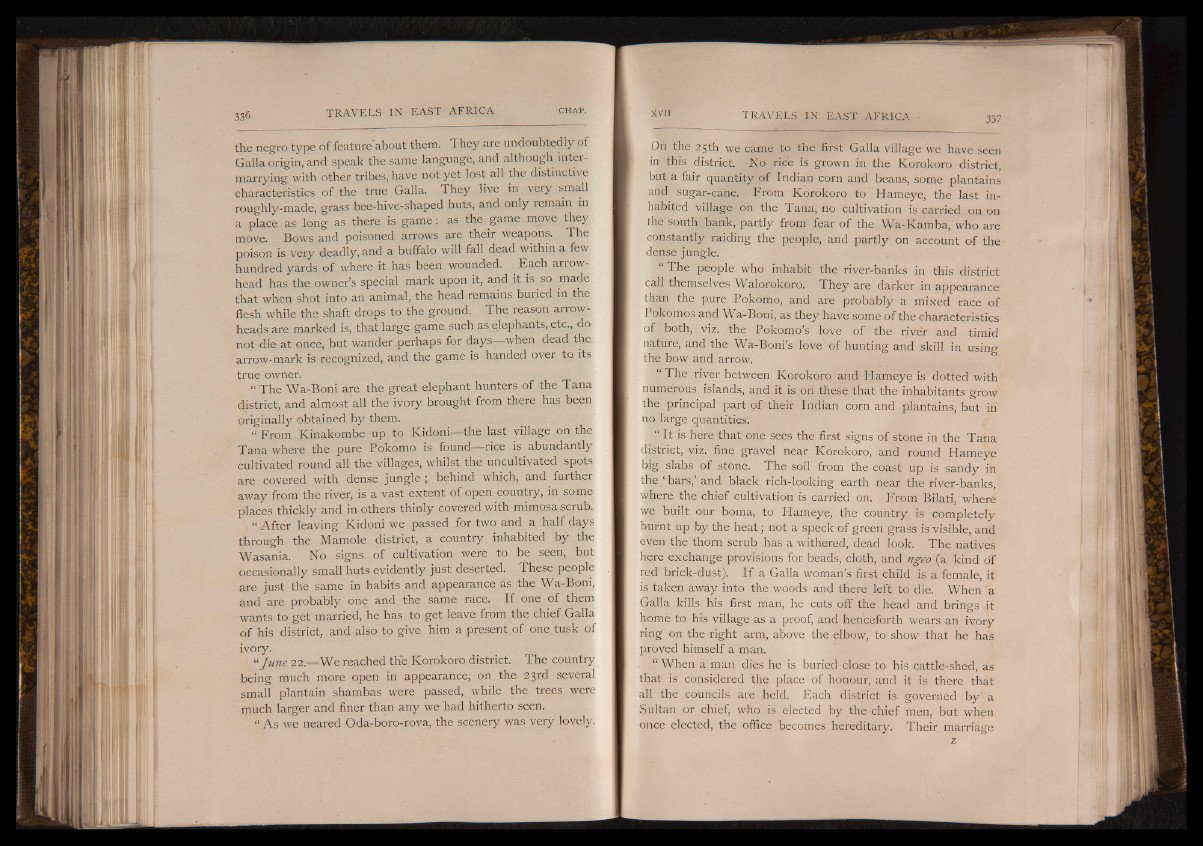
the negro type of feature about them. 1 hey are undoubtedly of
Galla origin, and speak the same language, and although intermarrying
with other tribes, have not yet lost all the distinctive
characteristics of the true Galla. They live in very small
roughly-made, grass bee-hive-shaped huts, and only remain in
a place as long as there is game: as the game move they
move. Bows and poisoned arrows are their weapons. The
poison is very deadly, and a buffalo will fall dead within a few
hundred yards of where it has been wounded. Each arrowhead
has the owner’s special mark upon it, and it is so made
that when shot into an animal, the head remains buried in the
flesh while the shaft drops to the ground. The reason arrowheads
are marked is, that large game such as elephants, etc., do
not die at once, but wander .perhaps for days- when dead the
arrow-mark is recognized, and the game is handed over to its
true owner.
“ The Wa-Boni are the great elephant hunters of the Tana
district, and almost all the ivory brought from there has been
originally obtained by them.
“ From Kinakombe up to Kidoni— the last village on the
Tana where the pure Pokomo is found rice is abundantly
cultivated round all the villages, whilst the uncultivated spots
are covered with dense jungle ) behind which, and further
away from the river, is a vast extent of open country, in some
places thickly and in others thinly covered with mimosa scrub.
“ After leaving Kidoni we passed for two and a halfdays
through the Mamóle district, a country inhabited by the
Wasania. No signs of cultivation were to be seen, but
occasionally small huts evidently just deserted. These people
are just the same in habits and appearance as the Wa-Boni,
and are probably one and the same race. If one of them
wants to get married, he has to get leave from the chief Galla
of his district, and also to give him a present of one tusk of
ivory.
. “June 22— We reached the Korokoro district. The country
being much more open in appearance, on the 23rd several
small plantain shambas were passed, while the trees were
much larger and finer than any we had hitherto seen.
“ As we neared Oda-boro-rova, the scenery was very lovely.
On the 25th we came to the first Galla village we have seen
in this district. No rice is grown in the Korokoro district,
but a fair quantity of Indian corn and beans, some plantains
and sugar-cane. From Korokoro to Hameye, the last inhabited
village on the Tana, no cultivation is carried on on
the south bank, partly from fear of the Wa-Kamba, who are
constantly raiding the people, and partly on account of the
dense jungle.
“ The people who inhabit the river-banks in this district
call themselves Walorokoro. They are darker in appearance
than the pure Pokomo, and are probably a mixed race of
Pokomos and Wa-Boni, as they have some of the characteristics
of both, viz. the Pokomo’s love of the river and timid
nature, and the Wa-Boni’s love of hunting and skill in using
the bow and arrow.
“ The river between Korokoro and Hameye is dotted with
numerous islands, and it is on these that the inhabitants grow
the principal part of their Indian corn and plantains, but in
no large quantities.
I It is here that one sees the first signs of stone in the Tana
district, viz. fine gravel near Korokoro, and round Hameye
big slabs of stone. The soil from the coast up is sandy in
the .‘ bars,’ and black rich-looking earth near the river-banks,
where the chief cultivation is carried on. From Bilati, where
we built our boma, to Hameye, the country is completely
burnt up by the heat; not a speck of green grass is visible, and
even the thorn scrub has a withered, dead look. The natives
here exchange provisions for beads, cloth, and ngeo (a kind of
red brick-dust). I f a Galla woman’s first child is a female, it
is taken away into the woods and there left to die. When a
Galla kills his first man, he cuts off the head and brings it
home to his village as a proof, and henceforth wears an ivory
ring on the right arm, above the elbow, to show that he has
proved himself a man.
“ When a man dies he is buried close to his cattle-shed, as
that is considered the place of honour, and it is there that
all the councils are held. Each district is governed by' a
Sultan or chief, who is elected by the chief men, but when
once elected, the office becomes hereditary. Their marriage